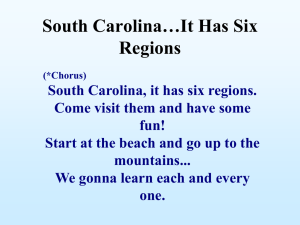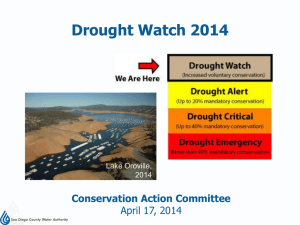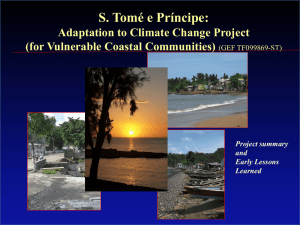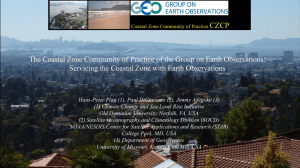Overview of Integrated Assessment and Modelling
advertisement
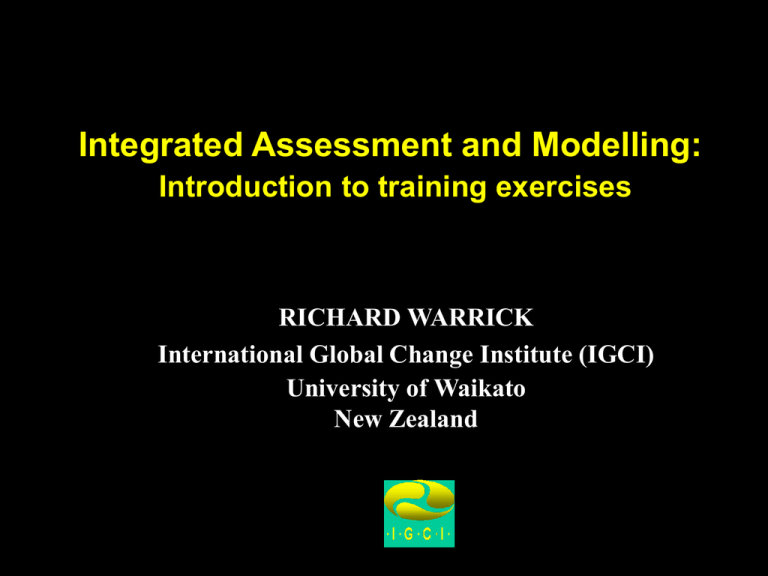
Integrated Assessment and Modelling: Introduction to training exercises RICHARD WARRICK International Global Change Institute (IGCI) University of Waikato New Zealand This presentation will: • Provide an overview of integrated assessment and modelling • Describe the SimCLIM system for national and sub-national assessments • Introduce the hands-on training session Part 1: Integrated Assessment and Models - Part I: Integrated Assessment Models - Integrated Assessment Models What is meant by “assessment”? - Climate impacts and adaptation - Assessment Process Assessments Technical analyses and studies FUTURE PAST What do we know? What don’t we know? What needs to be done? Priority gaps and needs? Products, e.g. time National Communications Project development - Part I: Integrated Assessment Models - Integrated Assessment Models What is meant by “integrated” assessment? - what is meant by integrated assessment? - Vertically integrated Global Global Warming Regional wetter Local sectoral agriculture drier - what is meant by integrated assessment? - Vertically integrated Global Global Warming Regional wetter Local sectoral agriculture drier - what is meant by integrated assessment? - Horizontally integrated Global Global Warming Regional Local sectoral coastal agriculture water Coastal Risk Drought Risk Flood Risk health Epidemic Risk - what is meant by integrated assessment? - Global Fully integrated Global Warming Regional wetter drier Local sectoral coastal agriculture water Coastal Risk Drought Risk Flood Risk health Epidemic Risk - Part I: Integrated Assessment Models - Integrated Assessment Models What is meant by integrated assessment “model”? Key components of full-scale IAMs Atmospheric Composition Atmospheric Chemistry Climate & Sea Level Climate Ocean •Temperature •Sea level Ocean Carbon Cycle Human Systems Ecosystems Energy System Other Human Systems Terrestrial Carbon Cycle Unmanaged Ecosystems Agriculture, Livestock & Forestry Coastal System Crops & Forests Hydrology (Weyant et al., IPCC, 1996) EXAMPLE: Asia-Pacific Integrated Model (AIM) (NIES, Japan) Study Area of AIM (NIES, Japan) End-to-end characterisation of IAMs Energy System Other Emissions Emissions Agriculture Atmospheric Composition Atmospheric Chemistry Ocean carbon Cycle Climate Climate & Sea Level Ocean •Temperature •Sea level Hydrology Coastal System Crops & Forestry Health & other Impacts (Weyant et al., IPCC 1996) EXAMPLE: MAGICC/SCENGEN Greenhouse gas emissions MAGICC Global mean temperature change SCENGEN Regional Scenarios of Climate Change GCM patterns Climatologies Part 2: The SimCLIM models for national and sub-national assessments The SimCLIM Models (the “first generation” structure) MAGICC outputs Other outputs Global-Mean Temperature and SeaLevel Projections National Climate Change Scenario Generator Userdefined model parameters Sectoral Impact Models Coast Agriculture Effects Water Health Climatologies GCM patterns Synthetic changes SimCLIM Models PACCLIM (Pacific Island region) VANDACLIM (island version) VANDACLIM (fictitious country) FijiClim (Viti Levu) CHAMP (New Zealand) CANCLIM (Canada) BDCLIM (Bangladesh) HOTSPOTS (NZ) OZCLIM (Australia) TOPOCLIM (NZ) CLIMPACTS (New Zealand) 1992 1993 1994 1995 1996 1997 1998 1999 2000 For Example: FIJICLIM Climate: Mean Annual Precipitation 2070 Example: FijiCLIM, Dalo Suitability Impacts: Current Average Climate El Nino Drought Climate Change 2050 with El Nino Drought GREEN = highly suitable soils and climate BROWN = least suitable SimCLIMs can be used to: • • • • • • • • • Describe baseline climates Examine current climate variability and extremes Assess risks – present and future Investigate adaptation – present and future Create climate change scenarios Conduct sensitivity analyses Project sectoral impacts of climate and sea level change Examine risks and uncertainties Facilitate integrated impact analyses A customised, prototype SimCLIM model can be developed for AIACC projects Data Required: • Spatially interpolated monthly climatologies • Time-series climate data for stations (monthly or daily) • Downscaled, standardised patterns of monthly temperature and precipitation changes from GCMs. • Digital elevation model (optional) Part 3: The “hands-on” training exercise - Hands-on Training Exercise - Objective To gain practical experience in: • selected elements of integrated assessment • using an Integrated Assessment Model - Hands-on Training Exercise - The “Republic of Vanda Islands” (an imaginary country) - Hands-on Training Exercise - Using: The Island Version Developed by the International Global Change Institute, University of Waikato, New Zealand - Hands-on Training Exercise - Problem Focus: Risk Reduction • Assess current climatic risks • Assess adequacy of current adaptation to climatic variability and extremes • Develop scenarios of future climate changes • Assess possible future changes in risk • Assess adaptation options for reducing future risks • Estimate incremental cost ratios - Hands-on Training Exercise - Choice of 4 Training Groups • Coastal Flood Risk (storm surges) • Agricultural Drought Risk • Risks of Groundwater shortage • Drought risk to water supply Aosis - Hands-on Training Exercise - Sessions • All four training groups in each session • No more than four persons per group • Each session repeated four times The End… Thank you for your attention



